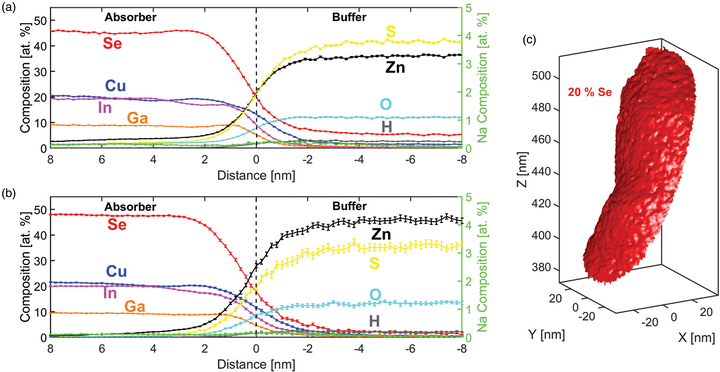Crossref Citations
This article has been cited by the following publications. This list is generated based on data provided by
Crossref.
Gault, Baptiste
Chiaramonti, Ann
Cojocaru-Mirédin, Oana
Stender, Patrick
Dubosq, Renelle
Freysoldt, Christoph
Makineni, Surendra Kumar
Li, Tong
Moody, Michael
and
Cairney, Julie M.
2021.
Atom probe tomography.
Nature Reviews Methods Primers,
Vol. 1,
Issue. 1,
Kühbach, Markus
Bajaj, Priyanshu
Zhao, Huan
Çelik, Murat H.
Jägle, Eric A.
and
Gault, Baptiste
2021.
On strong-scaling and open-source tools for analyzing atom probe tomography data.
npj Computational Materials,
Vol. 7,
Issue. 1,
Cojocaru-Mirédin, O.
Schmieg, J.
Müller, M.
Weber, A.
Ivers-Tiffée, E.
and
Gerthsen, D.
2022.
Quantifying lithium enrichment at grain boundaries in Li7La3Zr2O12 solid electrolyte by correlative microscopy.
Journal of Power Sources,
Vol. 539,
Issue. ,
p.
231417.
Coakley, Kevin J.
and
Sanford, Norman A.
2022.
Learning Atom Probe Tomography time-of-flight peaks for mass-to-charge ratio spectrometry.
Ultramicroscopy,
Vol. 237,
Issue. ,
p.
113521.
Raghuwanshi, Mohit
Chugh, Manjusha
Sozzi, Giovanna
Kanevce, Ana
Kühne, Thomas D.
Mirhosseini, Hossein
Wuerz, Roland
and
Cojocaru‐Mirédin, Oana
2022.
Fingerprints Indicating Superior Properties of Internal Interfaces in Cu(In,Ga)Se2 Thin‐Film Solar Cells.
Advanced Materials,
Vol. 34,
Issue. 37,
Ghasemifard, Mahdi
Ghamari, Misagh
and
Iziy, Meisam
2023.
Study of electron band structure of Pr doped ZnAl2O4 by reducing background in modified-CDB-spectroscopy.
Radiation Physics and Chemistry,
Vol. 206,
Issue. ,
p.
110800.
Jacob, Kevin
Khanchandani, Heena
Dixit, Saurabh
and
Jaya, Balila Nagamani
2023.
Suppression of Reverted Austenite in Cold-Rolled Maraging Steels and Its Impact on Mechanical Properties.
Metallurgical and Materials Transactions A,
Vol. 54,
Issue. 12,
p.
4976.
Yu, Yuan
Cojocaru-Mirédin, Oana
and
Wuttig, Matthias
2023.
Atom Probe Tomography Advances Chalcogenide Phase‐Change and Thermoelectric Materials.
physica status solidi (a),
Wu, Riga
Yu, Yuan
Jia, Shuo
Zhou, Chongjian
Cojocaru-Mirédin, Oana
and
Wuttig, Matthias
2023.
Strong charge carrier scattering at grain boundaries of PbTe caused by the collapse of metavalent bonding.
Nature Communications,
Vol. 14,
Issue. 1,
Lin, Nan
Han, Shuai
Ghosh, Tanmoy
Schön, Carl‐Friedrich
Kim, Dasol
Frank, Jonathan
Hoff, Felix
Schmidt, Thomas
Ying, Pingjun
Zhu, Yuke
Häser, Maria
Shen, Minghao
Liu, Ming
Sui, Jiehe
Cojocaru‐Mirédin, Oana
Zhou, Chongjian
He, Ran
Wuttig, Matthias
and
Yu, Yuan
2024.
Metavalent Bonding in Cubic SnSe Alloys Improves Thermoelectric Properties over a Broad Temperature Range.
Advanced Functional Materials,
Vol. 34,
Issue. 30,
Rau, Julia S.
Eriksson, Gustav
Malmberg, Per
Puente Reyna, Ana Laura
Schwiesau, Jens
Andersson, Martin
and
Thuvander, Mattias
2024.
Oxidation of a zirconium nitride multilayer-covered knee implant after two years in clinical use.
Acta Biomaterialia,
An, Decheng
Zhang, Senhao
Zhai, Xin
Yang, Wutao
Wu, Riga
Zhang, Huaide
Fan, Wenhao
Wang, Wenxian
Chen, Shaoping
Cojocaru-Mirédin, Oana
Zhang, Xian-Ming
Wuttig, Matthias
and
Yu, Yuan
2024.
Metavalently bonded tellurides: the essence of improved thermoelectric performance in elemental Te.
Nature Communications,
Vol. 15,
Issue. 1,
